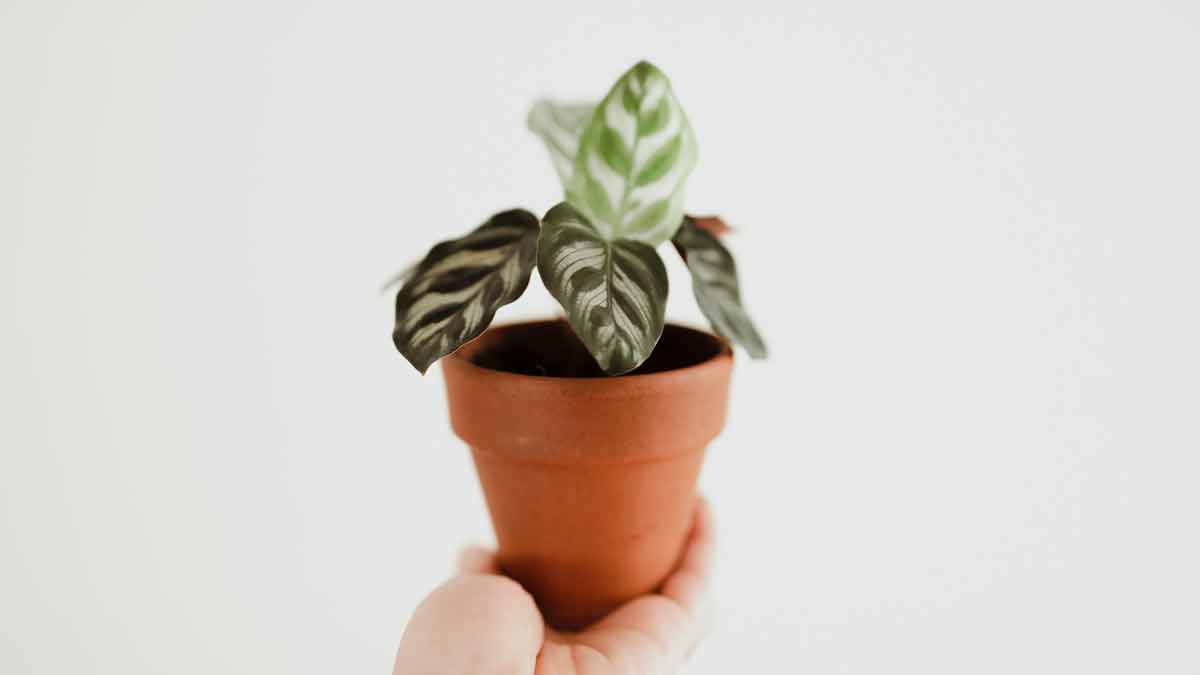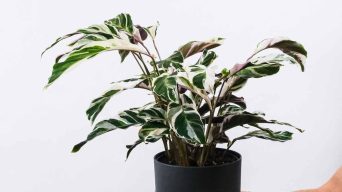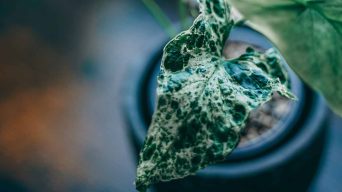There is a good reason why Calathea plants are one of the most popular houseplants. Their beautiful leaves often feature various designs and color combinations that make them aesthetically pleasing in any home.
However, many Calathea plants suffer from slow growth rates and an inability to reach full height. So how do you make a Calathea grow taller and faster, improving its growth rate?
Various tips will be discussed here for improving Calathea’s growth rate. We will cover topics such as soil and fertilization, how much light a plant should get, and other vital factors in ensuring healthy calathea growth.
By following these tips, you can ensure your calathea plant grows taller and faster than ever.
1. Provide Proper Lighting
The most critical factor in promoting the healthy growth of a Calathea is providing the right amount of light. It’s best to provide bright, indirect light that is not too hot or cold.
Depending on the variety, some calatheas can tolerate more direct sunlight than others. But never leave your plant in direct sunlight for an extended period, as this can cause sunburn or cause the leaves to turn yellow.
An east- or west-facing window is usually ideal. If your Calathea isn’t getting enough light, supplement with a grow light for about 12 hours of exposure each day.
Identifying and Fixing Lighting Issues
If your Calathea plant leaves exhibit yellowing or appear droopy and withered, it could indicate light-related issues, either excessive or insufficient light.
Examine the leaves; if they are yellowing, it’s likely because of too much light. Move your plant to a shadier spot or install sheer curtains or shades on windows to prevent too much direct sunlight from hitting it.
Conversely, if your Calathea leaves are drooping or look smaller than usual, it may be because of a lack of light. Move your plant to a brighter spot and consider purchasing a grow light.
Tips for Providing the Right Amount of Light
Some easy tips to remember when making sure your Calathea is getting the right amount of light are:
- Move your Calathea to a location with plenty of indirect light during the day, such as near a window or sunroom. You want to ensure the plant is in bright but not direct light.
- During the winter months, if you have a Calathea in an area with direct sunlight, try to reposition it closer to a window or other indirect light source to reduce the amount of sun it receives.
- Rotate your Calathea regularly so that all sides of the plant receive equal exposure to light.
- If you live where the sun isn’t available, consider investing in a grow light so your Calathea can still get the right amount of light.
- As with most plants, pay attention to how long and often your Calathea is exposed to natural or artificial sunlight and adjust accordingly.
Providing your Calathea with the right amount of light will give it the best chance to grow taller and faster while maintaining its health and beauty.
Remember that too much or too little light can cause damage, so make sure to give your plant the attention it needs and deserves!
2. Increase Humidity for Calathea Plants
Humidity is an essential factor to consider when growing Calathea plants. They thrive in high humidity, which can help them grow taller and faster.
The leaves can become dry and brittle when the humidity is too low. This not only impairs Calathea’s growth rate but can also lead to brown tips on the leaves.
Increasing Humidity for Your Calathea Plant
Fortunately, there are several ways to increase humidity for your Calathea plant. One of the easiest and most common methods is using a humidifier in the room where you keep it. This can help raise the ambient humidity to an optimal level, promoting better growth and healthier leaves.
Another option is setting up a water tray near the plant. The evaporation from the water will help raise the humidity in the air around it. When you do this, keep an eye on the water level so it doesn’t drop too low.
Misting your Calathea plant with a spray bottle filled with filtered or distilled water can also help increase humidity. This should be done sparingly, as too much misting can cause fungal or bacterial growth on the leaves.
Monitoring and Adjusting Humidity Levels
It’s important to monitor humidity levels and make adjustments as needed. You can measure the humidity in your home with a hygrometer. This tool will give you a better understanding of what kind of environment your Calathea needs to thrive.
If the humidity is too low, try one or more of the above methods to raise it. If the humidity is too high, try opening a window or turning on a fan to reduce the moisture in the air.
By monitoring and adjusting humidity levels, you can ensure your Calathea receives the optimal environment to grow bigger and faster.
3. Water Your Calathea Plant Properly
Water is essential for Calathea’s growth and development, so it’s important to water it properly.
If your Calathea is not getting enough water, its leaves will droop or turn yellow. Conversely, should it exceed a certain threshold, excessive moisture may result in soil saturation, potentially causing root rot.
Watering Your Calathea Plant
To water your Calathea, use filtered or distilled water if possible. Tap water can contain too many minerals and chemicals that harm the plant’s health.
Check the soil before you water. If it’s dry about an inch deep, it’s time to give your Calathea a drink. A soil moisture meter can help determine when the plant needs water.
Water your Calathea thoroughly until you see it draining from the bottom of the pot. Ensure not to let the plant sit in standing water, which can cause root rot and other problems.
By providing your Calathea with the right amount of water, you can help ensure it grows taller and faster.
4. Fertilize Your Calathea for Faster Growth
Fertilizing your Calathea plant can help improve its growth rate and increase its height.
Choose a fertilizer specifically formulated for indoor plants, such as an all-purpose liquid fertilizer or a balanced slow-release granular fertilizer.
Follow the label’s directions when applying fertilizer, and don’t over-fertilize your plant. Over-fertilizing can damage or even kill your Calathea plant due to too much salt buildup in the soil.
Apply fertilizer every two to four weeks during the growing season (spring and summer). During the winter months, there is no need to fertilize your Calathea plant.
By following these tips and applying fertilizer correctly, you can help improve the growth rate and increase the height of your Calathea plant. Properly fertilizing your Calathea will ensure that it thrives and grows tall, fast, and strong!
5. Repotting Your Calathea
Repotting your Calathea is a great way to help it grow faster and taller.
Repotting not only encourages growth but also provides the plant with fresh soil and fertilizer to feed on and gives it more room for its roots to spread out.
Calatheas must be repotted every two to three years or when their growth rate slows.
Tips for Repotting Calathea
Here are some tips to keep in mind when repotting your Calathea:
- Choose the right pot size. When selecting a pot for your Calathea, ensure it is slightly bigger than its current one. Plant roots need room to spread out and grow, so a larger pot will help you achieve faster growth.
- Ensure the pot has drainage holes. This will help prevent root rot, which can stunt the growth of your Calathea.
- Choose the right soil type. Calatheas prefer rich, organic soil with a pH balance between 6 and 7. Use light, porous soil that drains well and contains nutrients for your plant.
- Be gentle when handling the roots. When you move your Calathea from its current pot to the new one, try to be as gentle as possible with the roots. Too much agitation can cause them to break or even kill the plant altogether.
- Let the plant adjust to its new environment. After repotting, give your Calathea some time to adapt. This can be anywhere from a few days to a week. During this period, don’t water or fertilize the plant until it has had time to adjust.
By following these tips, you can help your Calathea to reach its full potential.
You’ll enjoy a healthy, vibrant Calathea with lush foliage and faster growth rates with adequate space and nourishment.
Not only that, but repotting also provides an opportunity to take a look at the root system and make sure everything is healthy.
6. Pruning for Improved Calathea Growth
Pruning is an important step in encouraging Calathea’s growth. When done correctly, it can help to promote healthy and robust growth, improving the overall look of your plant.
When plants don’t have enough room for new growth or old and dead leaves are left on the plant, this can slow down its growth rate. Removing these leaves gives your Calathea more room to spread and promote healthier growth.
Pruning is essential to keep your Calathea looking its best and growing faster.
Tips for Pruning Your Calathea
Here are some tips to help you get started when pruning your Calathea:
Wait until the plant is actively growing. Prune during spring or summer while the plant is actively growing and producing new leaves.
- Remove dead or damaged leaves. Look for any yellowing, wilting, or browning leaves and remove them to make room for new growth.
- Prune back long stems. Cut back overgrown branches and stems to promote new growth. This will help your Calathea look fuller and more even in shape.
- Use a clean, sharp pair of scissors or pruners. This will ensure that your cuts are clean and prevent damage to the plant’s structure.
- Be gentle with your pruning. Avoid damaging stems or leaves while pruning – this can slow growth and cause other issues.
Avoid over-pruning, which can lead to unhealthy growth and stress the plant. Prune only as much as necessary for improved health and aesthetics.
By following these tips and regularly pruning your Calathea, you will be able to promote healthier growth and encourage new leaves to appear. This will help your plant look fuller and more vibrant.
7. Common Pests and Diseases Affecting Calathea Plants
Pests and diseases can also affect Calathea plants and slow their growth rate. Preventing pest infestations and diseases is essential for keeping your plant healthy and thriving.
Pests
One of the most common problems with Calathea plants is pest infestation.
Some pests that may attack your plant include mealybugs, fungus gnats, aphids, thrips, scale insects, and spider mites. All of these can cause damage to your plant and reduce its growth rate.
To prevent or eliminate them, you should regularly inspect your plant for signs of infestation, such as white or brown spots on the leaves, and treat them with insecticidal soap.
Diseases
In addition to pest infestation, Calathea plants can also be affected by some common diseases that may reduce their growth rate. These include powdery mildew, root rot, crown rot, leaf spot, and blights.
To prevent these diseases, keeping your Calathea in the right environment and providing adequate care is essential. Most diseases can be prevented by ensuring the plant has proper drainage and watering thoroughly but not overwatering.
You should also ensure your plant receives enough light and air circulation to prevent mildew. Lastly, it’s important to regularly prune your Calathea to remove any dead or wilted leaves, as this can help prevent the spread of disease.
These preventive measures can help keep your Calathea healthy and promote faster and bigger growth.
With proper care, you should be able to maintain a healthy and attractive plant that grows quickly and produces beautiful foliage.
8. Temperature and its Impact on Calathea Growth
When it comes to growing Calathea plants, the temperature is an important factor for successful growth.
The ideal temperature range for most Calathea varieties is between 65-85 degrees Fahrenheit (18-29 degrees Celsius).
While some species may prefer temperatures slightly outside this range, any temperature below or above can lead to stunted growth and damage to the plant.
When temperatures are too low, the plant won’t be able to photosynthesize appropriately and thus cannot produce enough energy for growth.
If the temperature is too high, the plant can suffer from heat stress and dehydrate quickly, leading to wilting or the death of the Calathea plant.
It is, therefore, essential to maintain a consistent temperature range for your Calathea to encourage better growth.
The Impact of Temperature Fluctuations on Calathea Growth
It is also important to note that sudden temperature fluctuations can have an even more detrimental effect on Calathea growth.
Calathea plants are susceptible to rapid changes in temperature, which can cause them to become stressed, leading to poor growth and even death.
Therefore, it is essential to avoid abrupt temperature changes, as this could be detrimental to the health of your Calathea plant.
Maintaining a consistent temperature range and avoiding sudden fluctuations will help ensure that your Calathea grows tall and healthy.
Tips for Controlling Temperature for Calathea Growth
If you wish to maintain a consistent temperature range for your Calathea plant, there are some simple steps that you can take.
- If you are growing your Calathea indoors, use a thermostat to monitor and regulate the temperature inside your home.
- Use fans or air conditioners to cool off the room during hot days.
- Place the plant near a window that can receive indirect sunlight but away from direct drafts from windows or vents.
- If you are growing your Calathea outdoors, make sure to choose a spot that is shielded from wind and the sun.
- Cover the plant with a frost blanket during cold nights and provide temporary shade during hot days.
These tips will help ensure that your Calathea enjoys the ideal growing conditions, encouraging fast and healthy growth.
By providing your Calathea with the right temperature and avoiding sudden fluctuations, you can encourage it to grow taller and faster.
9. Soil Quality and Its Impact on Calathea Growth
Calathea plants need the correct type of potting soil to grow tall and fast. Specifically, they prefer well-drained, slightly acidic soil with high organic matter. The pH level should be between 5.5 and 6.5 for optimal growth.
You can add some compost or mulch to increase the potting mix quality and add nitrogen and other nutrients.
If your potting soil is too sandy, adding organic material like peat moss or compost can help with moisture retention and overall drainage.
Additionally, ensure the soil you’re using has good aeration so that oxygen can reach the roots of your plant.
Providing your Calathea with the right potting soil can ensure that it grows tall and fast. With a balanced blend of nutrients, moisture levels, and aeration, your plant will be able to reach its full potential in no time!
Final Thoughts
A Prayer plant, also known as Calathea, is a beautiful addition to any home. Its lush foliage and vibrant colors can liven up any space.
However, encouraging your Calathea to grow taller and faster requires some extra effort on your part. The key is to provide the right environment for optimal growth.
Ensure you provide the best light, soil, and moisture for your Calathea. It would be best if you also fertilized regularly to boost growth and use a quality potting mix that is well-draining.
Additionally, you can repot your plant every two years to give it additional space and encourage better root development.
With the proper care and attention, you can control how quickly your Calathea grows and have a vibrant, healthy plant for years to come.







